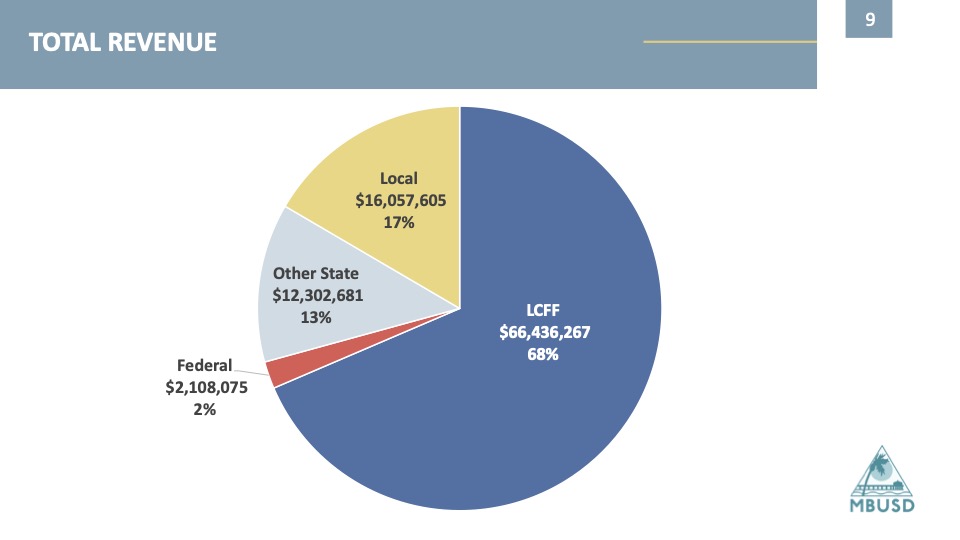by Mark McDermott
The Manhattan Beach Unified School District Board of Education adopted its 2023-2025 budget last week amid ongoing state funding uncertainties. But due to boosts in local funding, the school board was able to reduce previously approved teacher layoffs from 32.8 full time positions to 12.2, meaning that roughly 20 pink slips will be rescinded.
Voters’ renewal of the Measure MB parcel tax and the Manhattan Beach Education Foundations increase in fundraising were largely responsible for the district’s ability to reduce its layoffs. Local funding, which also includes property lease revenue, a facilities use agreement with the City of Manhattan Beach, and various grants, is now responsible for 17 percent of MBUSD’s $98.6 million general fund budget.
Deputy Superintendent Dawnalyn Murakawa-Leopard emphasized to the board that this amount of local support for public schools is extremely rare.
“It’s a highly unusual circumstance,” she said. “Most districts rely on state, local, and federal money, but not nearly the percentage of local funds that we do. And so we have worked very hard over the past many years to try to shore up those local revenue sources…and to continue to educate the community about the importance of local funds, to help people understand that this is really the way that we can control our own destiny and maintain the level of programs that we believe are important in our district.”
Trustee Bruce Greenberg expressed gratitude for the community’s extraordinary support for its schools.
“We’re just so fortunate to have the local sources of funding that we have, in MBEF, in our partnership with the City, and in the parcel tax,” he said. “Because, gosh, it’s stable local funding, and it’s really making a difference right now….in terms of being able to rescind most of the pink slips. I mean, that’s going to make a tremendous impact on our class sizes next year, which is going to benefit our students, and benefit our teachers.”
The district was also unexpectedly helped by a recent state budget compromise. The State of California faced a $47 billion budget deficit this year, and so earlier in their budget process, district leaders were bracing for steep cuts to education funding. But a deal worked out between the State Legislature and Governor Gavin Newsom last week, while cutting many state agencies and programs, managed to shield public schools from drastic cuts and even maintained small cost of living (COLA) increases.
“It’s generally good news for us,” Murakawa-Leopard said. “No major changes to K-12 education funding that will impact us directly.”
But not all budget developments were positive. MBUSD remains one of the lowest funded school districts in California, due the the state’s Local Control Funding Formula (LCFF), which prioritizes economically disadvantaged school districts in calculating Average Daily Attendance (ADA) funding. ADA represents the bulk of state education funding.
This chronic underfunding problem will be exacerbated going forward by a much lower ADA count. MBUSD, like most public school districts, experienced drastic enrollment declines during the pandemic, but the state froze enrollment calculations to pre-pandemic levels in its ADA funding in what was called a “hold harmless” budgeting mechanism. Before the pandemic, MBUSD’s student population hovered above 6,500 students; during the pandemic, it dropped as low as 5,852. Though enrollment has inched back up, the end of the “hold harmless” means both ADA counts and per-pupil funding from the state will be significantly lower.
Trustee Wysh Weinstein said that it’s important that the community understand the reasons behind this drop in funding.
“I think people forget that with ‘hold harmless’, we really benefited from it during Covid. We benefited a couple years out,” she said. “And we’re still benefiting. But next year, we don’t get that. We’re not able to calculate the ADA, which in turn, calculates LCFF, which is why you’re seeing that big drop. And so it’s really important to keep getting that message out there. We are not doing a bad job keeping up with enrollment….It’s really a function of how it’s calculated.”
Additionally, due to the underperformance of the CalPERS and CalSTRS public employment funds, employer contributions are close to tripling, from 10 percent in 2010 to close to 30 percent by 2027. What all these trends add up to is a widening structural gap between revenues and expenses. This fiscal year, expenses will be over $102.5 million and revenues at $98.6 million. Next year’s deficit is projected at $2.1 million, and the following year $1.27 million.
The budget approved by the school board at a special meeting June 20 used a combination of reserves and budget cuts to achieve the state-mandated balanced budget. The board cut $800,000 in maintenance and technology outlays, $40,000 in supplies and services, and $3.9 million through employee layoffs — which included part of a classified position and one management position in addition to 12.2 teaching positions. Ten more employee layoffs are projected next year, and seven the following year, after which the structural deficit is projected to no longer exist.
Despite these challenges, MBUSD has essentially dodged a bullet. Only a few months ago, budget cuts were projected at orders of magnitude larger over this and the next few years. Tellingly, at the June 18 meeting in which the budget was formally introduced, the agenda item directly following the Murakawa-Leopard’s presentation was the acceptance of a record $7.4 million in grants from MBEF. This was 20 percent more than last year’s MBEF contributions, and represented another unexpected boon.
Hilary Mahan, MBEF executive director, told the board that the mission going forward is even clearer — more and more local funding will be needed, due to the unstable nature of state budgeting, and MBUSD’s chronic underfunding. She noted that several high performing districts in the state have higher parcel taxes and hence higher per-pupil funding.
“It all comes down to local support, and we’ve known this for 40 plus years…The same thing with measure MB — it all comes down to local support with the vote,” Mahan said. “The fact that local funding is almost 20 percent of our district budget is pretty remarkable. I’d like to see it even higher. In those districts where local support is even higher, through many parcel tax campaigns, the per pupil funding is significantly higher. You simply have to rely on your local community to uphold the quality of education we hope for.” ER











